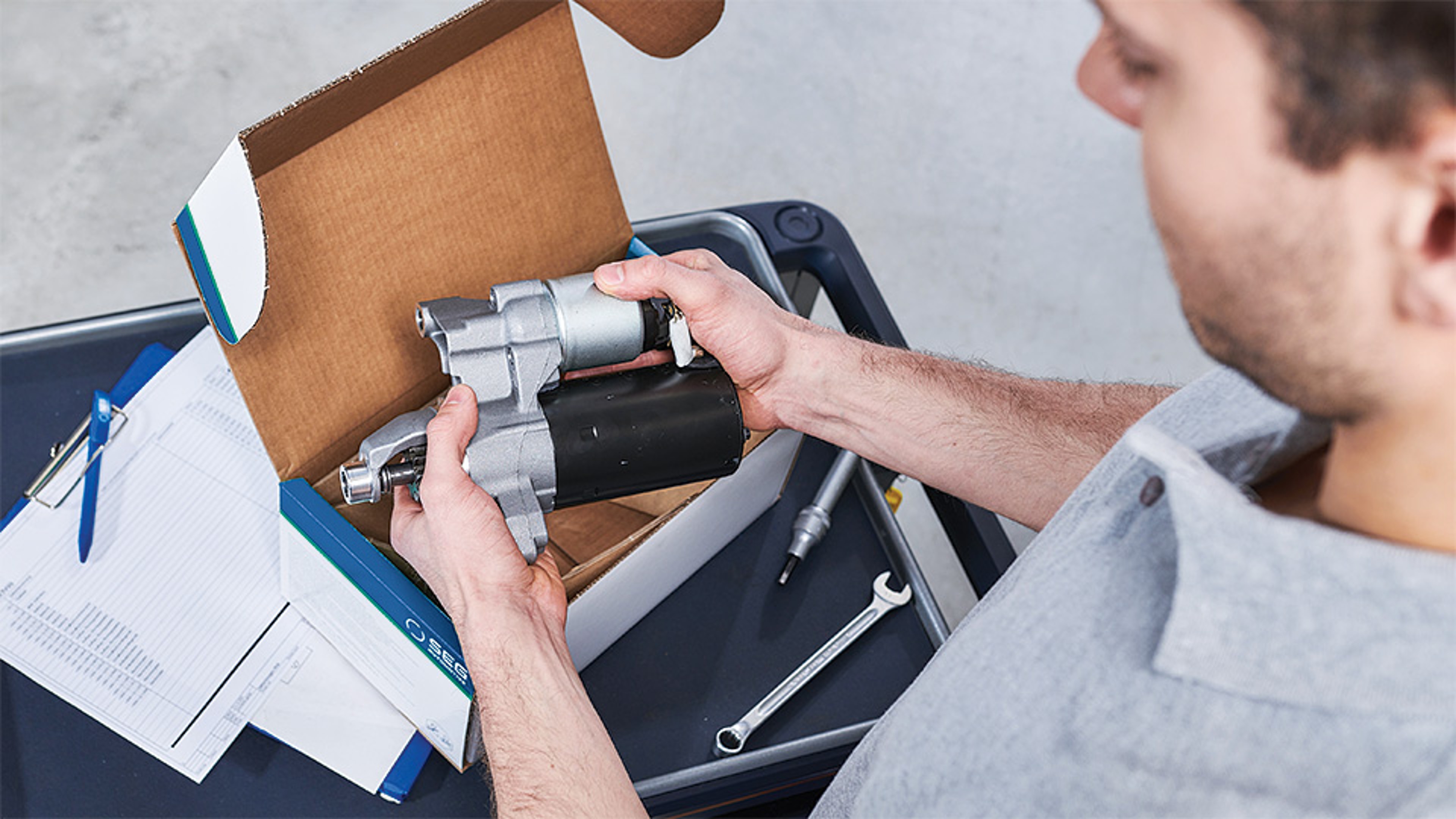Four important tips for identifying a faulty starter motor.
The starter is what gets a combustion engine moving. If it breaks down, the only option is usually to replace it. This makes it all the more important to recognize and interpret the signs that precede or accompany a failure to start.

What are the possible causes of a starter motor defect?
[Opens in a new tab] Since SEG Automotive began mass production of the starter motor 111 years ago (German), it has been operating according to the same well-proven principle: it converts energy from the vehicle's battery into mechanical energy, which sets the engine in motion. This motion, in combination with the ignition, starts the vehicle. If the starter motor fails, this process is impossible and the engine will not start.
The main reason for a starter motor defect is wear and tear. In addition, excessive strain can cause serious damage. Overuse occurs, for example, when the starter motor is activated while the engine is running or when it is operated for too long during the starting process.
If the engine does not start as usual for workshop customers, the starter should be allowed to cool down for a few minutes before trying again. If in doubt, have the vehicle towed to the workshop or—only for vehicles with manual transmission—push it and have it taken to the workshop.
Despite all precautions, it is impossible to avoid starter problems as the vehicle ages, as it is not replaced after a specified mileage during inspection. In order to avoid consequential damage to the vehicle in the worst case, it is therefore important to recognize possible signs of defects at an early stage.
Visual inspection in the engine compartment.
If the vehicle does not start, the first step at the repair shop should be a visual inspection—if possible, in the compact engine compartment. It is advisable to check the cable connections to the battery and starter, ensure that they are securely fastened, and verify that the main cable is not obstructed.
Signs of a defective starter motor.
If the visual inspection reveals nothing unusual, the following four points provide indications of possible damage. Customer experiences during the initial consultation at the workshop are helpful in narrowing down the problems.
1. No activation
If the engine doesn’t start when attempting to start the car, it’s often due to a burnt-out component in the starter or an issue with the solenoid. Another possible cause are worn carbon brushes in the starter, which are responsible for the electrical connection between the stationary and rotating parts of the motor. If they are worn out, the engine may no longer start reliably. A further explanation could be a depleted vehicle battery. It’s also important to pay attention to any error messages on the display – for example, a message like “Starter system faulty – workshop” may appear, accompanied by a yellow engine warning light or the battery indicator light.
2. Clicking sound
A single clicking sound when attempting to start the engine usually means that the starter is not receiving enough power. This can be caused by an electrical problem with the starter motor, the jumper cables, or the battery.
3. Ratcheting noise
If the gears connecting the starter to the flywheel are worn, a characteristic grinding noise similar to a “ratchet” can be heard. This can be caused by either the starter or the flywheel itself. It occurs when the gears no longer mesh correctly.
4. Unusual smell or smoke
In some situations, the starter may overheat because it is continuously supplied with power or because it did not switch off after ignition. In these cases, smoke is likely to be visible or the smell of burnt plastic may be noticeable coming from under the engine. Possible causes include a short circuit, a problem with the ignition switch, or damage to the vehicle's electrical system.
All of these cases should be examined more closely in the workshop as soon as possible.
Reliability through OE quality parts.
If the starter needs to be replaced, it is advisable to use OE quality parts. SEG Automotive, one of the leading original equipment suppliers, produces these for the aftermarket on the same lines as the original starters for new vehicles. This means that they are of identical quality and also undergo the same quality tests.
WHAT MAKES A HIGH-QUALITY STARTER?
- From the development stage onwards, the focus is on maximum resilience and durability.
- High cycle endurance is the basis for a long service life. While cheap imports often only allow 12,000 starts, conventional starters from OE production can withstand 40,000–60,000 starts. For start/stop starters, the ratio is up to 400,000 starts for a quality product compared to 200,000 for a cheap import.
- Reliable cold starts, smooth running, and low noise levels ensure high customer satisfaction.
- Guaranteed accuracy of fit facilitates installation of the replacement starter in the workshop and ensures optimum tracking.
[Opens in a new tab] Remanufactured starters are a cost-effective and environmentally friendly alternative that can be up to 30 percent cheaper. At [Opens in a new tab] SEG Automotive, they come with the following product promise: equivalent to or better than the original part installed in the vehicle. During remanufacturing, not only are all defective or worn parts replaced, but improvements and further developments made to the starter since the vehicle was first registered are also incorporated.
Cheap imported goods are not recommended. Their quality varies considerably and is difficult to assess from their appearance. The use of inferior materials and poor workmanship often lead to unpleasant surprises during operation.

Aftermarket Marketing Contact
SEG Automotive
Ullrich E. Schaab
[Opens in a new tab]
ullrich.schaab@seg-automotive.com